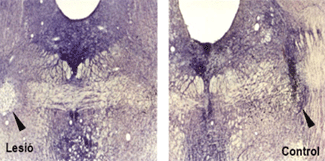Cerebrals abnormalities that affect learning

Complex learning, attention processes and other high cognitive processes require an optimal level of arousal in highly evolved brain areas, such as cerebral cortex and related regions. In turn, for an optimal functioning level, these areas must receive modulatory influences from structures located at lower levels (for example, the brainstem), usually phylogenetically old. Functional anomalies of those modulatory structures are related to motor and cognitive disturbances that are characteristic of certain kinds of dementia and psychopathological disorders, as well as of some learning and attention disorders in otherwise healthy people.
One of the structures having a modulatory role on higher brain regions is the pedunculopontine tegmental nucleus (PPTg), located in the brainstem. A research team of the Psychobiology unit and Neuroscience Institute of the Universitat Autònoma de Barcelona have investigated, in rats, the consequences of damage to this nucleus on the ability to quickly adapt to new cognitive demands.
Specifically, the animals learnt that, when a specific innocuous stimulus (conditioned stimulus or CS: a light in half the subjects and a tone in the other half) was present, they had to move to other compartment of the training box in order to avoid an unpleasant stimulus (unconditioned stimulus). Initial learning was quicker when the CS was a tone than when it was a light, due to evolutionary reasons: auditory stimuli have higher saliency than visual stimuli for nocturnal rodents. Once the animals had learnt the task, they received either a lesion of the PPTg, or the corresponding control procedures (without lesion).
After recovery, the rats were again trained in the same task, but now the CS was a tone in the animals initially trained with a light, and vice-versa. Both damaged and control animals were capable of adapting their responses to the new situation and in all the groups the response was better when the new stimulus was auditory (salient stimulus for the species) than when it was visual (low ecological saliency). However, in all the circumstances animals with PPTg lesion showed a slower and less efficient adaptation than controls, partially due to attention deficiencies and to difficulties in establishing new relationships between conditioned and unconditioned stimuli.
The main contribution of this work is that it helps in having better knowledge about the role of the modulatory encephalic structures on cognitive processes; in future this knowledge may contribute to design therapeutic interventions capable of reducing certain learning disturbances.
Figure 1. A. Localization of the Pedunculopontine tegmental nucleus (PPTg) in the rat brain (similar localization and kind of neurons of this nucleus are found in humans). B. Microphotograph of PPTg region in an animal with a lesion (left), and in a control rat (right). The damaged area is characterized by huge loss of neurons (white region indicated by the arrow), while in control rats there are a lot of neurons in this region (black spots indicated by the arrow).
Figure 2: Evolution of the number of correct responses (A) and of the latencies of responses (B) during initial training, before the lesion (left graphs), and after damaging the PPTg and changing the conditioned stimulus (right graphs). The groups depicted with a triangle were first trained with a light and then with a tone, while training was made in the inverse order in the groups depicted with a square. Initial learning is quicker (higher number of correct responses and lower latencies) when a tone is used as the conditioned stimulus, since, due to evolutionary reasons, rats are better prepared to attend to auditory stimuli than to visual stimuli. In spite that the changes in the training conditions are highly challenging for both lesioned and control animals, adaptation to the new conditions is much slower and less efficient in rats with damage to the PPTg, due to altered attention and to difficulties in forming new associations between the learning related stimuli.
References
Homs-Ormo, S.; Torras-Garcia, M.; Portell-Cortés, I.; Edo-Izquierdo, S.; Morgado-Bernal, I.; Coll-Andreu, M. (2007) "Effects of posttraining damage to the pedunculopontine tegmental nucleus on conditioned stimulus transfer in two-way active avoidance in rats". Behavioral Neuroscience, 121(2): 411-421.

